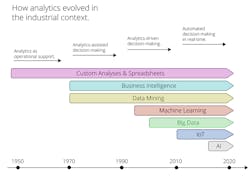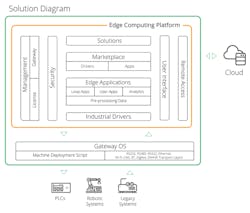Many machine or equipment manufacturers are looking to offer new services to their customers to enable additional revenue streams, and Industrial Internet of Things (IIoT) technology provides a way to accomplish that goal.
Industrial machine manufacturers have been performing data analytics for years—since the 1950s. However, that data took a long time to collect, analyze, and then slowly be used to make operational decisions. Later the industry adopted business intelligence tools, which led to better analytics and decision-making. Today, the real value is coming into play as IIoT comes of age with machine learning and the onset of artificial intelligence.
As IIoT evolves we are moving from data-assisted decision-making to automated decision-making in real-time.
Major manufacturers are turning to IIoT to optimize efficiency, increase overall equipment effectiveness, and minimize costs. OEMs can get started with IIoT by bundling a small IoT gateway with their machines. The key to taking that system one step further is to include an edge computing platform. These platforms are largely accepted as a solution to IIoT challenges for their simplicity, built-in security, and interoperability with varied legacy devices. The global smart manufacturing platform market is projected to grow from $4.4 billion in 2019 to $10.8 billion by 2024, according to MarketsandMarkets.
In order to see how OEM services have evolved, let’s consider a boiler manufacturer, for instance. Twenty years ago, a boiler was just a boiler—it only heated water. About 10 years ago the manufacturer may have added a connected sensor to the boiler to start collecting basic data points such as temperature and condensation. Now, forward-thinking OEMs can easily bundle a small IoT gateway with an edge computing platform inside of the boiler to enable easily additional services and future revenue possibilities such as remote monitoring and predictive maintenance.
Instead of just collecting temperature and condensation data, they can offer remote monitoring services to allow the customer to adjust from afar when temperature gets too high. Or, over time they can use that valuable data to determine when something might go wrong with a predictive maintenance solution. Including an edge computing platform with the IoT gateway gives them all of the brains they need for future application enablement at the Edge.
The Benefits of an Edge Computing Platform
Let’s start by defining an edge computing platform to make sure we are all on the same page. An edge computing platform is installed on an IoT gateway right next to the asset on the factory floor. Secure connectivity is one of the main purposes of the platform, and then the platform uses a local message broker to collect data from all the varied industrial devices and pre-processes, then filter, analyze, and store it locally. Then it makes the data available to other applications as needed, most often to the cloud.
The factory floor has a large variety of legacy systems, PLCs, and robotic systems, all with varied protocols. As a result, most factories have a very large gap between old and modern equipment keeping them from adopting new industrial IoT solutions. One of the most common problems I see in factories is the need to connect these varied physical devices to whatever end-user software application they are using in the cloud. In order to connect to a wide variety of systems, the OEM must adopt a device and network-agnostic industrial edge computing platform that can fill the gap and accommodate the various protocols and PLCs. With a good platform, the OEM can easily manage the flow of data and decision making between devices and cloud or on-premise applications.
I have noticed that ease of deployment is the number one consideration for most OEMs, and with the right edge computing platform, all assets can be seamlessly connected to the cloud. With a good platform, the OEM can easily manage the flow of data and decision making between devices and Cloud or on-premise applications. Furthermore, when OEMs find the right platform to fill that gap—from the edge device to the cloud—they can add value such as the beforementioned predictive analytics or remote access.
An edge computing platform bundled with an IoT gateway can simplify connecting legacy systems and enabling new services.
Once all the machines on the factory floor (and at various locations) have a smart edge computing platform, OEMs can also add a centralized management system to the Cloud to quickly install, update, and manage applications across a large number of devices and locations. Another word for this layer might be an edge application orchestration layer. In the Cloud you can pull data from all the different pieces of equipment and manage all edge computing platforms at various sites. Administrators can have full control over how devices are configured and monitored, and how applications are orchestrated from the cloud to edge devices to optimize and manage complex analytics, anomaly detection, and machine learning across all their edge devices. The management layer also provides a central portal to monitor the status of equipment, push updates, and alert customers to potential issues.
The Benefits of Industrial IoT Increase Over Time
Upon adding the IoT gateway and edge computing platform next to a device on the factory floor, OEMs can offer their customers and users a basic service—typically real-time data visualization via a web-based or mobile app. Extracting data from a machine or asset that the customer already owns and visualizing data points is a good way to begin. However, as the market grows and matures, the OEM can start to envision other features and see the opportunity to enable multiple services that will attract customers and add additional revenue streams.
Let’s go back to our boiler example. On day one after implementation, OEMs will already be able to give customers value out of the connected IIoT solution—data visualization about their boilers so they can see when everything is normal or not performing optimally. Then, over time by collecting data from all of the various boilers with an edge computing platform and management layer in the cloud, they can start monitor things like boiler temperature, pressure, moisture, and other variables for system health in real-time.
After collecting data for a bit, they can use machine learning to determine what variables might lead to a maintenance issue and predict it before it happens. They can offer services such as system updates and remote monitoring of every asset from the cloud. The more data that is collected, the more intelligent the system becomes.
Another benefit to adding an IoT gateway and edge computing platform to equipment is future-proofing. Edge computing platforms allow for change without requiring a whole new system. A centralized management interface makes it easy to manage devices, security, and data collection for many different data types and also provides the ability to manage edge computing devices and deploy new applications and analytics at the edge.
How OEMs can Add New Services Via IIoT
After data visualization, the next services OEMs enable are largely predictive. The customer wants to prevent points of failure and this type of predictive maintenance requires services bundled as applications, which can be realized through IIoT. Not to mention that the OEM can now take an old asset, and charge a monthly fee to include an asset improvement service thanks to the IoT gateway and edge computing platform already installed from the start.
OEMs can enable new services by installing a new application that can provide more value on top of the existing system, which ensures their future with the customer is secure with multiple services. Adding new services is mutually beneficial since the OEM furthers its revenue stream while the customer gets more from their initial investment.
So, how can OEMs easily push new applications to the machine or asset at their customer site, enabling another service for the customer? Enabling software-driven IIoT infrastructure and services is the only way to continually add new services, and the edge application orchestration layer in the cloud makes it simple and easy to do. An IIoT solution enables users to seamlessly connect all industrial devices and systems, liberating processing and integrating data from the factory floor into cloud or on-premise systems.
Industrial IoT integration leads to deep insights into equipment on the factory floor.
This technology inherently offers continuous improvement. For example, the OEM could realize over time that vibration is causing anomalies from specific boiler data points. Now the OEM can sell an application that monitors vibration to mitigate problems. The list goes on and on of how the OEM can continue to deploy new services with an IoT gateway on their equipment and by bundling an edge computing platform. IIoT integration creates the opportunity for deep insights into equipment usage and maintenance practice.
John Younes is co-founder and COO of Litmus Automation.




